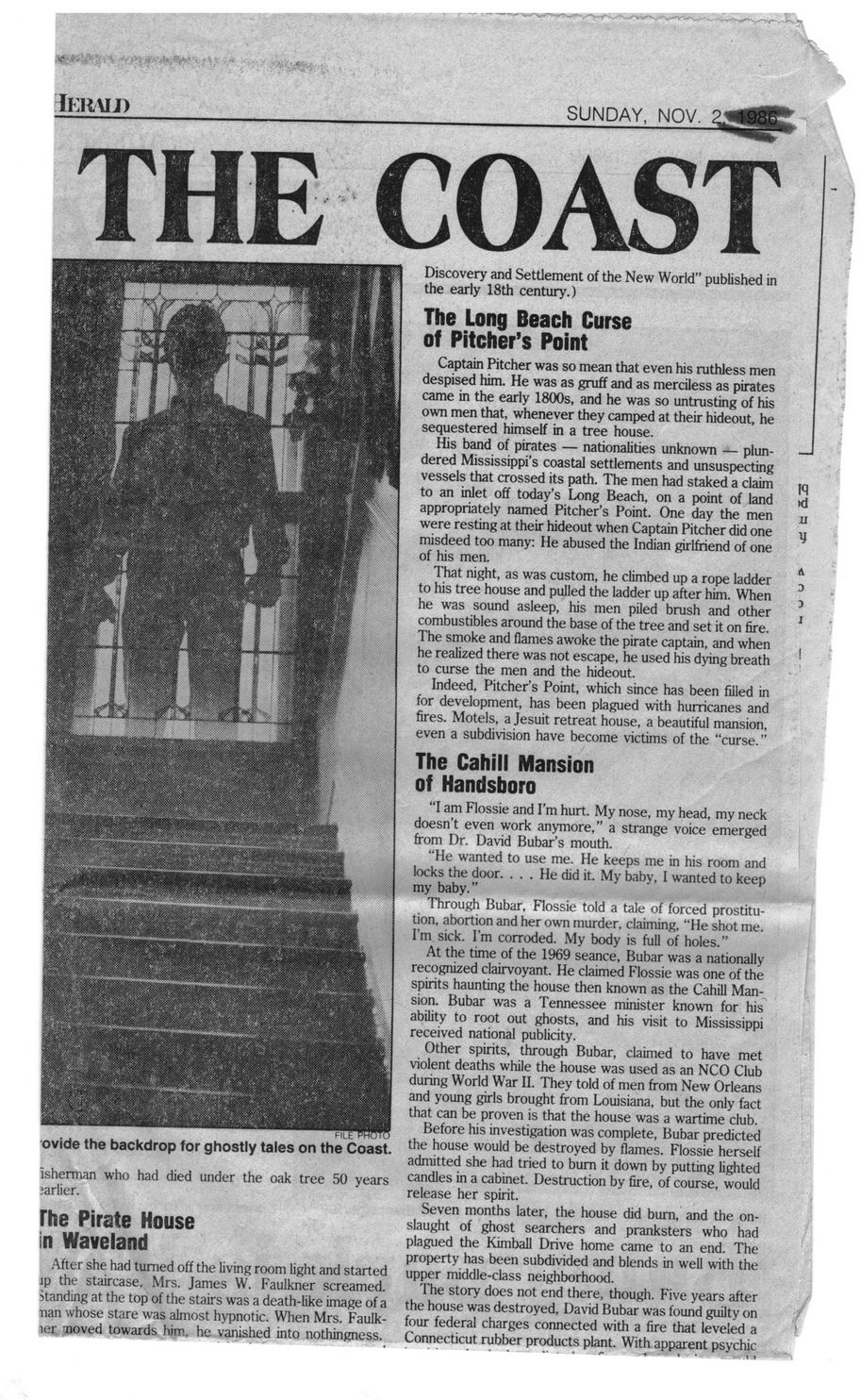This text was obtained via automated optical character recognition.
It has not been edited and may therefore contain several errors.
•? IERUJ) SUNDAY, NOV. THE COAST ■ovide the backdrop for ghostly tales on the Coast. isherman who had died under the oak tree 50 years earlier. The Pirate House in Waveland After she had turned off the living room light and started jp the staircase, Mrs. James W. Faulkner screamed, standing at the top of the stairs was a death-like image of a nan whose stare was almost hypnotic. When Mrs. Faulk-ler noved towards him. he vanished into nothingness. Discovery and Settlement of the New World” published in the early 18th century.) The Long Beach Curse of Pitcher’s Point Captain Pitcher was so mean that even his ruthless men despised him. He was as gruff and as merciless as pirates came in the early 1800s, and he was so untrusting of his own men that, whenever they camped at their hideout, he sequestered himself in a tree house. His band of pirates — nationalities unknown — plundered Mississippi’s coastal settlements and unsuspecting vessels that crossed its path. The men had staked a claim to an inlet off today’s Long Beach, on a point of land appropriately named Pitcher’s Point. One day the men were resting at their hideout when Captain Pitcher did one misdeed too many: He abused the Indian girlfriend of one of his men. That night, as was custom, he climbed up a rope ladder to his tree house and pulled the ladder up after him. When he was sound asleep, his men piled brush and other combustibles around the base of the tree and set it on fire. The smoke and flames awoke the pirate captain, and when he realized there was not escape, he used his dying breath to curse the men and the hideout. Indeed, Pitcher’s Point, which since has been filled in for development, has been plagued with hurricanes and fires. Motels, a Jesuit retreat house, a beautiful mansion, even a subdivision have become victims of the “curse. ” The Cahill Mansion of Handsboro “I am Flossie and I’m hurt. My nose, my head, my neck doesn't even work anymore,” a strange voice emerged from Dr. David Bubar’s mouth. “He wanted to use me. He keeps me in his room and locks the door. ... He did it. My baby, I wanted to keep my baby.” Through Bubar, Flossie told a tale of forced prostitution, abortion and her own murder, claiming, “He shot me. I’m sick. I’m corroded. My body is full of holes.” At the time of the 1969 seance, Bubar was a nationally recognized clairvoyant. He claimed Flossie was one of the spirits haunting the house then known as the Cahill Mansion. Bubar was a Tennessee minister known for his ability to root out ghosts, and his visit to Mississippi received national publicity. Other spirits, through Bubar, claimed to have met violent deaths while the house was used as an NCO Club during World War II. They told of men from New Orleans and young girls brought from Louisiana, but the only fact that can be proven is that the house was a wartime club. Before his investigation was complete, Bubar predicted the house would be destroyed by flames. Flossie herself admitted she had tried to bum it down by putting lighted candles in a cabinet. Destruction by fire, of course, would release her spirit. Seven months later, the house did bum, and the onslaught of ghost searchers and pranksters who had plagued the Kimball Drive home came to an end. The property has been subdivided and blends in well with the upper middle-class neighborhood. The story does not end there, though. Five years after the house was destroyed, David Bubar was found guilty on four federal charges connected with a fire that leveled a Connecticut rubber products plant. With apparent psychic N >d

Hancock County History General Newspaper Clippings Hancock-County-Ghosts-(3)